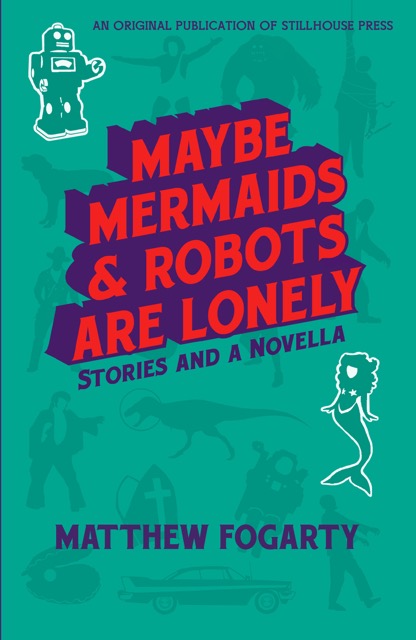Editor’s Note: Matthew Fogarty will be giving away a copy of his new collection, Maybe Mermaids and Robots Are Lonely, to the author of the story he chooses for publication. He will be reading all stories submitted September 12-18 2016.
Your new book Maybe Mermaids and Robots Are Lonely is a collection of stories, mostly flash fiction. Many of the stories star monsters, fantastical creatures, or pop culture icons, but none of them seem gimmicky or have punch lines. I really admire how much depth the stories have and the true emotion that comes through. Can you talk about your process for writing these stories? How much thought did you put into striking the balance between whimsical and serious, humorous and tragic?
Well first, thanks for the kind words—it really means a lot! And to your question, I’m not sure I put much thought at all into striking a balance; I think it just kind of happened. Similarly, I’m not sure there was any one process. It’s just kind of what and how I write, which very much reflects what and how I like to read.
I’d say most of these stories started the same way: something in the world stands out—in the normal course of a day, there’s something that registers or that breaks through the ordinary. It could be a thought, an emotion, an idea. More often, it’s an inkling, a word or a phrase, a look, a sound, an arrangement of light. And then writing, for me, is a process of taking those little bits and pieces and pairing them up with things I enjoy, that I like to think about or write about or read about, and giving it all time to let the little bits feed the interests and vice versa. Until one day—I haven’t figured out how or why—but some day, it all achieves a sort of heft or weight and it spills out.
Which all sounds much more serious and thoughtful than it really is. I enjoy exploring on the page and I enjoy finding the humor in big moments and the tragedy in small moments. I love entering through the whimsical and finding the serious. And I try very hard not to take myself or my writing too seriously, to write the things I’d enjoy reading. That’s how this book came about.
Can you talk a bit about the structure of the book? How did you go about arranging and categorizing your flash? Did you have to write a lot of new material to fit in, or did you have to cut a lot of ‘your darlings’ that didn’t fit?
When I sent it out, the manuscript had 40 stories and a novella. The finished product is 34 stories and a novella. So yeah, there were a few stories that were stripped out. Which is all credit to my editor at Stillhouse Press, Justin Lafreniere. As I was pulling the manuscript together, I included everything I had that I thought was a decent, if not great fit. Justin really forced me to peel away some of the stories that were either too similar to other stories in the book or that, hard as I tried to justify, didn’t quite fit in the collection.
As far as organizing the stories, again I have to give credit to Justin and the Stillhouse team. They were able to approach the manuscript fresh and see the flow of stories over the course of the book. I think I’d initially wanted the stories to echo each other and throw out ideas and questions th at would ultimately feed into the novella at the end. Justin, coming at it from a reader’s perspective, saw a different arc for the book, and his was the right approach.
at would ultimately feed into the novella at the end. Justin, coming at it from a reader’s perspective, saw a different arc for the book, and his was the right approach.
One thing I didn’t notice until I’d written most of the stories is that they all exist in certain spaces relative to each other—some deal primarily with what’s underground, some deal with what’s in the air or what’s above in space. We took that as an organizing principle and the stories all kind of fell into place.
What specific, tangible things, in your opinion, make for good flash?
One thing I love about flash fiction is that there are no rules and anything is possible. Especially if you look at stories by, for example, Stuart Dybek and Etgar Keret and Amelia Gray and so many others. There’s a great collection I love by Yasunari Kawabata. I guarantee that whatever things I could say I think make for “good” flash, each of those authors has proven wrong probably more than once.
That said, a few things I think about in my own writing and that I tend to look for in others’ work:
- Movement—Because we’re dealing with so little space, so few words, there’s a temptation to cast a beautiful or weird or brilliant image or premise or moment and just end there. Rarely does that ever feel like enough. To me, there’s got to be some movement, some reason why this image or this moment is important. Something has to be different, even if only in some small, barely perceptible way. Something has to have changed or moved so as to justify the telling of this story. Movement implicates emotion. To me, as fiction writers, emotion is our currency. It’s what makes a story come alive and stay alive for a reader.
- Uniqueness—This is a terrible word and I don’t mean it. What I mean, really, is that I want to see a story that only the author of that story could have written. I guess some people call it voice, but I dislike that word too. It’s the prime mover—what drives you to write, what makes you want to write rather than do whatever other, more normal people do in their spare time. It’s the one thing that’s different for each of us, the one thing that distinguishes us in this world of stories that sometimes feel like they’ve all been told before. It’s what Annie Dillard calls giving voice to your own astonishment, something that’s yours and only yours, something that you were set here to write.
- Cleanliness—By all means, use the F word. What I mean by cleanliness is this: we have so few words. 1000 words is nothing. As in life, in flash fiction, we don’t have time for unnecessary words or wrong words. I value stories where there’s no space wasted, where every sentence, every word, every punctuation mark is deliberate and doing the most work it can do in service of the story, whether that work is advancing the plot or shaping an image or setting a rhythm or simply making the story more beautiful. Simply, every word counts.
Though again, I’ve been proven wrong. The beauty of flash is that it’s the one form of fiction where someone writing true can make possible the impossible.
What story lines, topics, settings, situations, themes, etc. would you like to see more of in flash publications? And what’s been done to death?
I don’t know that there’s anything that’s been done to death. I think there’s always room for more love stories, for example. The trick is to find some new way of looking at it, some new thing that makes a well-worn story fresh again, that gets us to see the world from an angle we’ve never tried. And it’s hard to say what I’d love to see more of, because what I really want out of a story—I think what any of us want—is something I’ve never seen before, something I’ve never thought about before or some new angle or perspective or emotion or what-have-you. I love to hear voices I’ve never heard before or to read authors whose voices have historically been muted or underrepresented.
Take all of that together, and I’m not sure I’ve offered much. I like stories that have some element of magic, stories that explore ground-level territory (meaning, they’re raw and unflinching, opening doors we don’t normally open, like, for example, what it means to have to do manual labor 9 to 5 for 40 years).
Finally, I’m obsessed with the game Punderdome. So, make your best pun combining “monsters” and “country songs.”
Oh man. I hate that I love puns. But I gotta say, I don’t know a whole lot of country songs—I literally just Googled “title of a famous country song.” If you’d chosen any other genre (Nosferatu Live Crew, Predatori Amos, The Grim Reapearl Jam (Eddie Shredder)), I’d be better. A friend has offered:
- “Boot Scootin’ Boogeyman,”
- “Coal Minotaur’s Daughter”
- “Stand By Your Mothman.”
I don’t know. Billy Ray Cyrus the Virus? (Or is a reference to the 1997 Cage/Cusack classic Con Air too obscure? Malkovich was pretty monstrous in that role.) Brooks and Dunh Dunh Dunh? “Mamas Don’t Let Your Babies Grow Up to Be Krampus?”
Boot Scootin’ Boogeyman is brilliant. Here are mine:
- Mummies Don’t Let Your Babies Grow Up to Be Cowboys
- Fiends in Low Places
- Troll Miner’s Daughter
- Take This Blob and Shove It
- Banshee Thinks My Tractor’s Sexy



 The core workshop of SmokeLong Fitness is all in writing, so you can take part from anywhere at anytime. We are excited about creating a supportive, consistent and structured environment for flash writers to work on their craft in a community. We are thrilled and proud to say that our workshop participants have won, placed, or been listed in every major flash competition. Community works.
The core workshop of SmokeLong Fitness is all in writing, so you can take part from anywhere at anytime. We are excited about creating a supportive, consistent and structured environment for flash writers to work on their craft in a community. We are thrilled and proud to say that our workshop participants have won, placed, or been listed in every major flash competition. Community works.